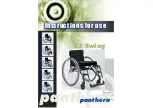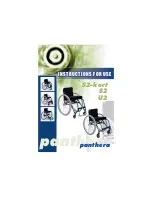
25
3
3. Before Sitting in the Wheelchair
3.1. Inspecting the Wheelchair
Inspect your wheelchair each time you use it to make sure the wheelchair is in safe operating condition.
Always follow the inspection and maintenance procedures and schedules described in the Owner’s Manu
-
al (see “11. Maintenance, Daily Check, Periodic Inspection”). If you detect any problem, contact your deal
-
ership.
(1) Anti-tip device
Check the anti-tip device which is installed to your wheelchair frame to ensure that it is not deformed
or greatly damaged.
Check the safety wheels of the anti-tip device to ensure that they are in the correct position for
operation.
Check that the safety wheels on the ends of the anti-
tip devices are 35-50 mm (1.4-2.0 inches) above the
ground when the casters and rear wheels are in contact
with the ground.
If the distance between the safety wheels and the
ground is not within this range, contact your dealership.
Check that the distance between the center of the
wheelchair back pipe (where the axles of the rear wheels
are installed) and the center of the safety wheels on the
ends of the anti-tip devices is 245 mm (9.7 inches) or
more. If the distance is less than 245 mm (9.7 inches),
contact your dealership.
245 mm
(9.7 inches)
35-50 mm
(1.4-2.0 inches)
WARNING
● The wheelchair may tip over if operated when the anti-tip device is removed or the safety
wheels are not in the correct position. Do not operate the wheelchair when the safety
wheels are not in the correct position. Only have the safety wheels folded or facing
upwards when going over bumps with the assistant operations and other such situations.
● Continuing to use the wheelchair with a problem in the wheelchair body or the wheels may
cause sudden damage to the wheelchair while traveling, and may result in a rollover or fall.
















































